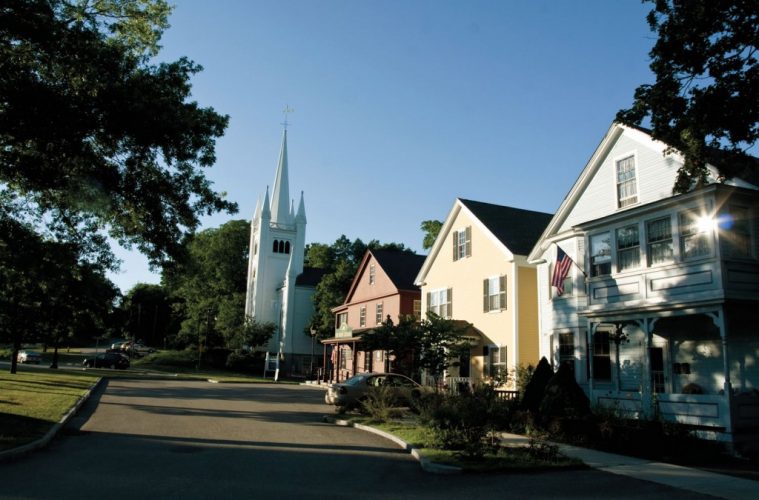Farm stands and green spaces give North Andover a rural vibe. By Diane Blair
Head to North Andover on a golden autumn day and you’ll encounter a series of vignettes that might have been painted by Norman Rockwell: here, a toddler picking out a pumpkin twice her size at a local farm stand; there, two young boys, casting fishing lines at Lake Cochichewick. Nearby, along the woodsy pathways of Weir Hill, ruddy-cheeked runners navigate the trails as their dogs (adorable, of course) bound along beside them. Cue the happy older couple, walking along the lakeside hand-in-hand-yup, there they are!
Does it get any cuter or more wholesome than this? Welcome to North Andover, a town that was named the “Fifth Best Community to Live on the East Coast” by Money magazine in 2003. Long-time residents agree: the magazine got it right. “This is a wonderful place to raise a family,” says Denise Frick, who’s lived in North Andover for more than 16 years. “You can zip into Boston in no time, but there’s such a contrast here,” she says, noting the small-town feel of the place.
It’s different than that other Andover, too. Donna Caselden, who has lived in both Andover and North Andover, says the latter feels like the country cousin of its more sophisticated relative. “North Andover is greener than Andover. It has a lot of farms and open spaces,” she says.
While Andover is known for its snazzy boutiques, North Andover is famous for its farm stands. For example, there’s Smolak Farms, where you can see fallow deer and other critters, pick up a jar of peach preserves, eat housemade pizza, and let the kids loose on the playground. Then there’s Barker’s Farm Stand, where you can load up on fresh produce, including “the best sweet corn in town,” according to Frick; and there’s Boston Hill Farm, with its gourmet grocery and pick-your-own strawberries, blueberries, peaches, and pumpkins. If it’s country charm you’re looking for, North Andover is your place.
But not all of the town’s green space is devoted to farmland. Beautiful natural spots like Weir (pronounced “Wire”) Hill entice residents to come out and play in any season. Once part of a 500-acre private estate located on Lake Cochichewick, Weir Hill offers four miles of hiking trails, a beautiful stand of birch trees, and, from the top, views of the lake to the east and Merrimack Valley to the west-a patchwork quilt of rosy hues this time of year. Come winter, it’s also a great place for snowshoeing.
Harold Parker State Forest is another go-to destination for outdoor fun. The park’s 3,500 acres are shared with North Reading, Middleton, and Andover, but there’s plenty to go around, including 11 ponds for fishing and (non-motorized) boating, and a campground. The landscape of rolling hills, swamplands, and rocky outcroppings is laced with more than 35 miles of logging roads and trails, great for biking, hiking, and horseback riding.
So how did there get to be two Andovers? As it happens, North Andover came first. The fertile land along the banks of the Merrimack River was once called Cochichewick Plantation (Cochichewick means “a place of great cascades” in the Penacook language.) The Penacook Indians sold the property to the Reverend John Woodridge in 1646 for a sum of six pounds a Red Coat. (“That sounds trivial to us, but red was a very difficult and expensive dye, and English clothing was seen as a desirable oddity,” says Carol Majahad, executive director of the North Andover Historical Society.) The name was changed to Andover, in honor of Andover, England. A dispute over the location of church sites led to the establishment of two parishes, North Parish and South Parish, in 1709. As the two different communities grew, they ultimately separated into two townships, formally on April 7, 1855.
Today, the North Parish Church serves as a stunning centerpiece in North Andover’s “Old Center” on the town common. Church bells that were cast by Paul Revere still peal, although they ring electronically now. Marked by a tall bronze statue of Phillips Brooks, the common is the setting for outdoor concerts, children’s festivals, and a popular sheep-shearing demonstration. Across the street, the North Andover Historical Society offers exhibits, a summer camp for kids, tours of the Old Burial Ground, and events like a recent quilting competition. Nearby, the historic Stevens-Coolidge House is a bustling scene during the annual plant sale, when residents arrive early (and bring wagons) to get the best choice of perennials.
Lively as this neighborhood can be, it isn’t “downtown,” really-locals consider downtown to be Main Street, located off Route 125 (Osgood Street). That part of town is a major commercial zone, offering shops and services that cover all the basics, unless you count Prada and Louis Vuitton among your daily necessities. And of course, you’ve got North Andover’s shopping standout, the farm stand. When it comes to that perfect, jack-o-lantern-worthy pumpkin, nobody does it better than North Andover.
The Details
Date of Settlement: 1644. Date of incorporation: 1855. Zip code: 01845. Population: 28,362. Total area: 27.8 square miles. Median household income: $99,467. Schools: North Andover High and Middle, Atkinson Elementary, Franklin Elementary, Kittredge Elementary, Sargent Elementary, Thomson Elementary, and private schools including Brooks School, Meritor Academy, Saint Michael Elementary School, and Merrimack College. Notable residents: Anne Bradstreet, poet; Samuel Osgood, first Postmaster General of the U.S.; Phillips Brooks, former rector of Trinity Church in Boston and lyricist (“O Little Town of Bethlehem,”); Moses Stevens, textile manufacturer; James Spader, actor; Gerry Cheevers, former NFL goalkeeper Steve DeOssie, former NFL linebacker; Zak DeOssie, NFL linebacker.

